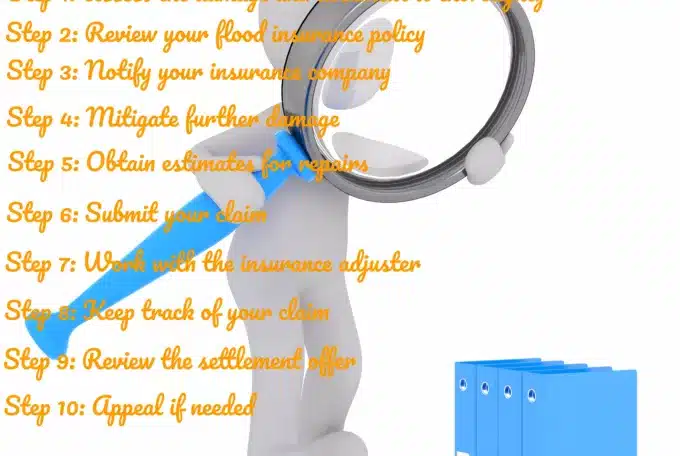A Step-by-Step Guide to What to Do After a Hurricane
Hurricanes are an unfortunate reality that homeowners must prepare for when living in Florida. While we hope you never have to experience the devastation of a hurricane, it is essential to be prepared and know what to do in case one hits. In this step-by-step guide, we will walk you through the actions you should take after a hurricane to ensure your safety, protect your property, and navigate the insurance claims process. From assessing damage to documenting losses to working with public adjusters, we’ve got you covered. Don’t let the aftermath of a hurricane overwhelm you – let us guide you through the process and help you get back on your feet. In case the Hurricane was accompanied by Flooding, we’ve written a similar step-by-step guide to flood damage.
What to do immediately after a hurricane?
After a hurricane has passed, it’s essential to prioritize your safety and assess the damage to your property. Here are some steps to take immediately after a hurricane:
1. Ensure your safety: Before venturing outside, make sure it’s safe to do so. Watch out for downed power lines, broken glass, and other hazards. If you have evacuated, wait for official clearance before returning home.
2. Document the damage: Take photos and videos of the damage to your property, both inside and outside. This evidence will be crucial when filing an insurance claim.
3. Check for structural damage: Assess the structural integrity of your home. Look for cracks in walls, foundation damage, or any signs of instability. If you suspect significant damage, contacting a professional before re-entering your property is best.
4. Mitigate further damage: Take immediate steps to prevent further damage, such as covering broken windows with tarps, shutting off utilities if necessary, and removing debris around your property.
5. Contact your insurance company or have your Public Adjuster contact them. Notify your insurance company as soon as possible about the damage. Follow their instructions for filing a claim and provide them with the necessary documentation and evidence.
6. Secure temporary housing if necessary: Make arrangements for temporary housing if your home is uninhabitable. Check with local authorities or your insurance company for assistance and resources available to you.
Remember, the aftermath of a hurricane can be overwhelming, but taking these steps will help you begin the recovery process and ensure a smoother claim settlement with your insurance company.
Common mistakes to avoid after a hurricane
After a hurricane, taking the proper steps to ensure your safety and protect your property is crucial. One of the most recent Florida Hurricanes was Hurricane Idalia. However, it’s equally important to avoid common mistakes that hinder recovery. One common mistake to avoid is not documenting the damage properly. Take photos and videos of all the damage to your property, inside and outside, especially before any changes are made, like repairs, even if they are temporary. This evidence will be invaluable when filing an insurance claim. Another mistake to avoid is delaying the filing of your claim. It’s essential to notify your insurance company as soon as possible to initiate the claims process. Waiting too long can result in complications and potential denial of your claim. Additionally, avoid throwing away damaged items before your insurance adjuster has had a chance to inspect them. Keep all damaged items and make a detailed inventory. Lastly, be cautious of fraudulent contractors who may take advantage of the situation. Research and verify the credentials of any contractors before hiring them for repairs. By avoiding these common mistakes, you can navigate the post-hurricane process more effectively and maximize your chances of a successful recovery.
Start repairing the damage.
After a hurricane, it’s urgent to start the claims process immediately. The earlier you start, the quicker you’ll resolve it and get the necessary funds to repair your home. Hiring a Public Adjuster will further simplify and speed up the process. The next step is to assess the extent of the damage to your property. Take photos or videos of any visible damage for insurance purposes. Next, prioritize any urgent repairs to prevent further damage or safety hazards. Refer to these as temporary repairs or mitigation. Remember, the Insurance Company can claim that you have prejudiced their inspection if you make actual repairs. This could include covering broken windows, tarping roofs, or boarding up damaged areas. Document all repairs and keep invoices and receipts for any expenses incurred at Fraser Property & Adjusting. They can help navigate the insurance claims process and ensure you receive fair compensation for your losses. Always prioritize safety and consult with professionals when necessary during the repair process.
File an insurance claim?
Filing an insurance claim after a hurricane is an essential step in the recovery process for homeowners. Here is a step-by-step guide on how to navigate this process:
1. Document the damage: Take photos and videos of the damage to your property as soon as it is safe. Make sure to capture the extent of the damage from different angles.
2. Review your insurance policy: Familiarize yourself with the details of your insurance policy, including coverage limits and deductibles. Take note of any specific requirements or deadlines for filing a claim.
3. Contact your insurance company: Notify your insurance company as soon as possible to initiate the claims process. Provide them with all the necessary information, including the date and location of the hurricane and a detailed description of the damage.
4. Mitigate further damage: Take reasonable steps to prevent further damage to your property. This could include covering broken windows, tarping damaged roofs, or boarding up exposed areas.
5. Keep records: Document all communication with your insurance company, including the names of representatives you speak with and the date and time of each conversation. Record any receipts for expenses related to temporary repairs or accommodations.
6. Obtain estimates: Get multiple estimates for the repair costs from reputable contractors. Provide these estimates to your insurance company for their review.
7. Be patient and persistent: The claims process can take time, especially after a widespread natural disaster. Regularly communicate with your insurance company and follow up on any outstanding items or requests for additional documentation.
Remember to hire a public adjuster from Fraser Property & Adjusting to navigate the insurance claim’s complexities and ensure you receive a fair settlement for your damages. We do it all; most importantly, we only get paid when you do.
How to prepare for a hurricane?
Preparing for a hurricane is crucial to ensure the safety of your home and family. Here are some steps to follow:
1. Stay informed: Stay updated with the latest weather forecasts and warnings from local authorities. Sign up for emergency alerts and have a reliable source of information. Here are some of the Best Disaster Relief Organizations and Resources in Florida.
2. Create an emergency plan: Develop a comprehensive plan that includes evacuation routes, a communication strategy, and a designated meeting point for family members. Practice the plan regularly.
3. Secure your home: Reinforce windows and doors with storm shutters or plywood. Clear your yard of loose objects that could become projectiles in high winds. Trim trees and shrubs to reduce the risk of falling branches.
4. Stock up on supplies: Have a well-stocked emergency kit that includes non-perishable food, water, flashlights, batteries, a first aid kit, and essential medications. Aim for at least a three-day supply.
5. Protect important documents: Gather important documents like insurance policies, identification, and proof of ownership for valuable belongings. Store them in a waterproof container or digitally back them up.
6. Review your insurance coverage: Ensure your homeowner’s insurance policy adequately covers hurricane-related damages. Consider purchasing flood insurance if you live in a high-risk area.
7. Stay connected: Keep your mobile devices fully charged and have backup power sources, such as portable chargers or generators. Maintain a list of emergency contact numbers.
Remember, it’s always better to be over-prepared than underprepared when it comes to hurricanes. These steps can help minimize the potential damage and keep you and your loved ones safe during a storm.





